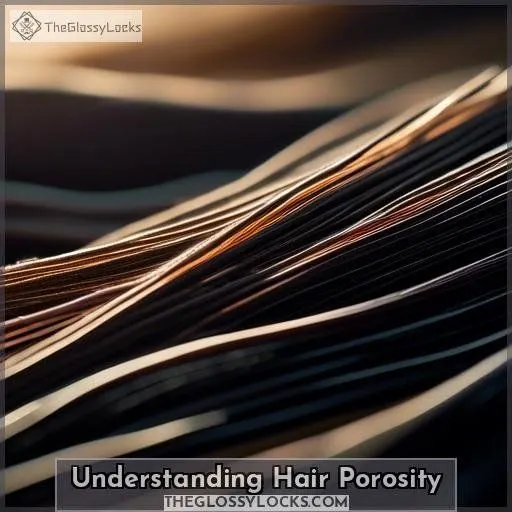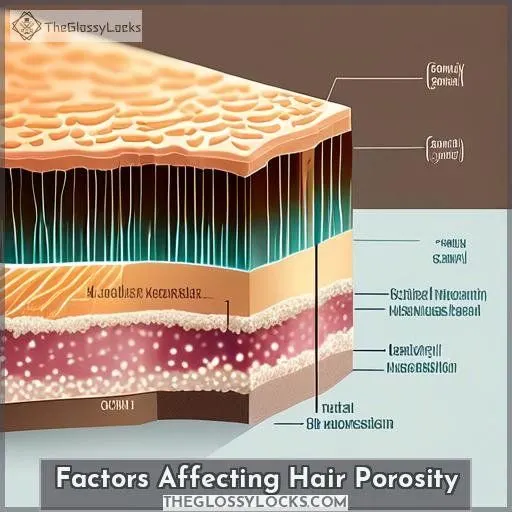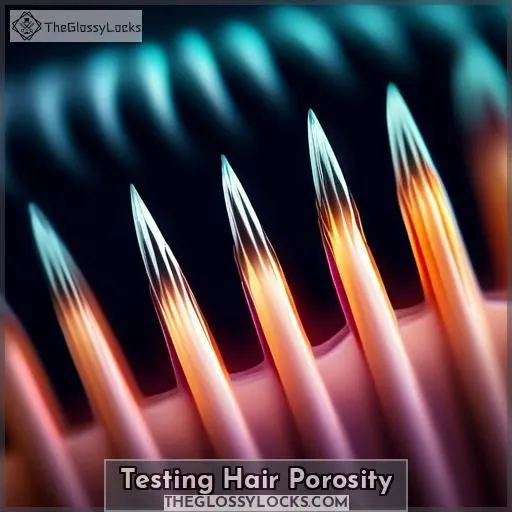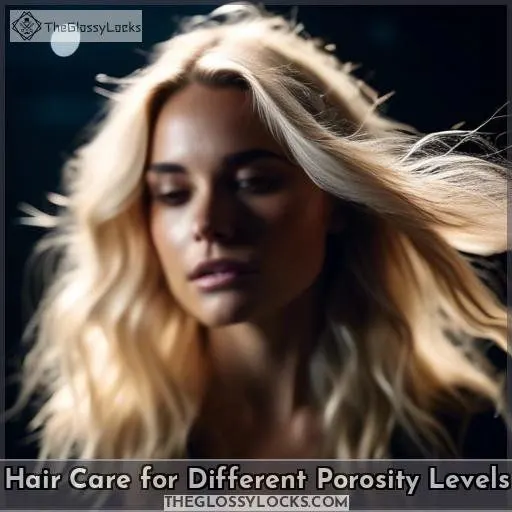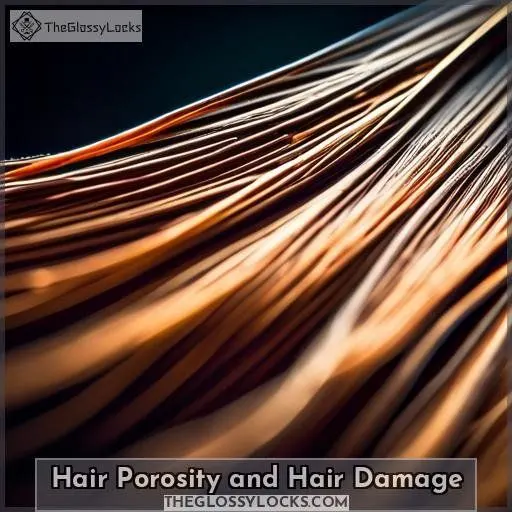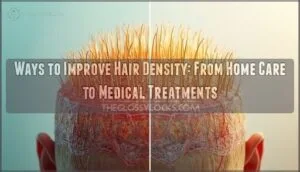This site is supported by our readers. We may earn a commission, at no cost to you, if you purchase through links.
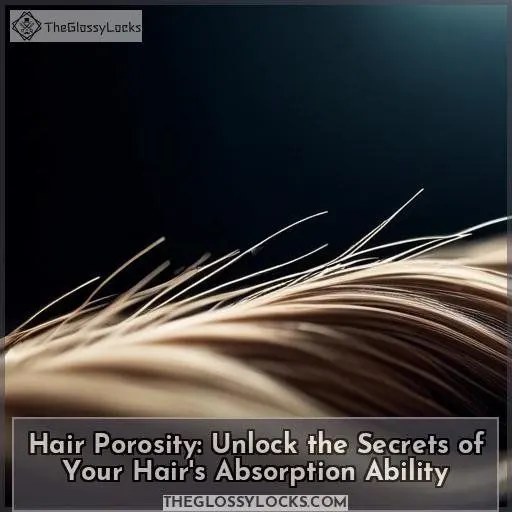 Your hair’s porosity, the ability to absorb and retain moisture, governs its texture and manageability.
Your hair’s porosity, the ability to absorb and retain moisture, governs its texture and manageability.
Genetics, environmental factors, and chemical treatments all influence hair porosity.
You can assess your hair’s porosity through tests like the float, sink, or strand test.
Low porosity hair requires moisture-rich products.
Medium porosity benefits from balanced moisture and protein.
High porosity craves butters, oils, and leave-ins.
High porosity hair is more vulnerable to damage, with enlarged cuticle gaps leading to breakage.
By understanding your hair’s porosity level, you’ll uncover the secrets to optimizing its absorption ability and achieving your desired results.
Table Of Contents
Key Takeaways
- Hair porosity is a crucial factor in determining the texture, manageability, and health of hair.
- Genetics, environmental factors, and chemical treatments all play a role in shaping hair porosity.
- Low porosity hair requires moisture-rich products, while medium porosity hair benefits from balanced moisture and protein.
- High porosity hair is more vulnerable to damage and requires butters, oils, and leave-in products to retain moisture.
Understanding Hair Porosity
Ever wondered why some hair drinks up conditioners like a parched plant, while others repel moisture like a duck’s back?
That’s hair porosity at play.
Imagine your hair as a sponge. Low porosity hair has a tight squeeze, resisting water and products. High porosity hair, on the other hand, has a more open structure, soaking up moisture but struggling to keep it locked in.
Normal porosity strikes a balance, offering easier moisture retention and frizz control.
It’s all in the cuticle structure—your hair’s natural armor against the daily grind.
Factors Affecting Hair Porosity
Your hair’s porosity level is primarily determined by your genetic makeup, which influences the structure and density of your hair cuticles. However, environmental factors like UV exposure, heat styling, and chemical treatments can also have a substantial effect on hair porosity by causing cuticle damage or altering the hair’s internal structure.
Genetics and Hair Porosity
Genetics play a significant role in determining your hair’s porosity.
Your genetic predisposition influences factors like follicle shape, hair thickness, and scalp health, ultimately affecting your hair’s ability to absorb and retain moisture.
Ethnic variations can also impact hair porosity, with some groups naturally having high or low porosity hair.
Understanding your genetic makeup can help you choose the right hair care products and regimen for your hair type, ensuring ideal hair health and appearance.
Environmental Factors and Hair Porosity
Environmental factors play a significant role in determining the porosity of your hair. UV exposure, pollution, humidity, and temperature can all impact the cuticle layer of your hair, affecting its ability to absorb and retain moisture. Here are some key points to keep in mind:
- UV Exposure: Prolonged exposure to the sun can damage the hair cuticle, leading to changes in porosity.
- Pollution: Particulate matter from air pollution can bind to the hair and scalp, potentially causing damage and affecting porosity.
- Humidity and Temperature: High humidity can cause frizziness in high porosity hair, while low humidity can make low porosity hair appear dry.
To care for your hair based on its porosity level, take into account the following tips:
- Low Porosity Hair: Use protein-free conditioners, apply conditioner to wet hair, and avoid products with oils.
- Medium Porosity Hair: Maintain a balanced moisture level with protein treatments and use products that address your hair’s specific needs.
- High Porosity Hair: Use products with butters and oils, leave-in conditioners, and heat protectants to help retain moisture.
Chemical Treatments and Hair Porosity
Chemical treatments can notably impact hair porosity, resulting in diverse alterations in the hair’s composition and appearance. Here’s an analysis of how distinct treatments influence hair porosity:
- Bleach Effects: Bleaching your hair can enhance its porosity, making it more vulnerable to damage and fading. This occurs because bleach eliminates the protective layer of the hair cuticle, permitting greater penetration of moisture and products.
- Protein Treatments: Protein treatments are frequently recommended for bleached hair to facilitate the repair of weakened strands. However, excessive use of protein treatments can render hair excessively porous, causing it to absorb color swiftly and dissipate it more rapidly.
- Deep Conditioning: Overuse of deep conditioning treatments can also augment hair porosity, as the frequent application of dense products can saturate the hair cuticle, making it more susceptible to damage and fading.
- Skin Care Products: Certain skin care products, particularly those containing aggressive chemicals, can compromise the hair cuticle, leading to greater porosity and potential hair damage.
To maintain optimal hair porosity, consider the following:
- Avoid Excessive Use of Chemical Treatments: Limit the frequency of bleaching, protein treatments, and deep conditioning to prevent substantial damage to your hair cuticle.
- Make Prudent Choices: Opt for gentle, sulfate-free shampoos and conditioners, as well as products that incorporate natural oils like coconut and argan oil, which can contribute to maintaining hair health.
- Safeguard Your Hair: Utilize heat protectants when styling with heated tools, and don a hat or employ a UV protectant spray when exposed to the sun to minimize damage from environmental factors.
Testing Hair Porosity
Testing hair porosity is essential to understanding how your hair absorbs and retains moisture.
There are several methods to determine your hair’s porosity, including the float test, sink test, water test, and strand test.
The float test involves dropping a hair strand into a glass of water; if it sinks, your hair has low porosity, while floating indicates high porosity.
The sink test involves wetting your hair and checking if it sinks; if it does, it may indicate water absorption or hair density.
The water test involves observing how quickly water beads on your hair; if it beads, your hair has low porosity, while absorbing quickly indicates high porosity.
The strand test involves examining the texture of your hair; if it’s smooth, your hair has low porosity, while bumps indicate high porosity.
These tests can help you customize your hair care routine to your hair’s specific needs.
Hair Care for Different Porosity Levels
Understanding your hair’s porosity is essential for preserving its well-being and aesthetic appeal.
Low porosity hair demands moisture-rich products and warmth during conditioning to improve moisture retention.
Medium porosity hair thrives with balanced moisture and protein treatments to maintain its health.
High porosity hair requires products with butters and oils, leave-in conditioners, and heat protectants to prevent rapid moisture loss.
Personal care regimens should be customized to your hair’s specific needs for optimal porosity maintenance.
Hair Porosity and Hair Damage
Understanding hair porosity is essential for preserving healthy hair.
Hair with high porosity is more vulnerable to damage because of its enlarged cuticle gaps, which facilitate the quick absorption and loss of moisture. This can result in breakage and diminished elasticity.
To safeguard high porosity hair, utilize products containing butters and oils. Employ heat protectants and avoid using hot water for washing. Regularly apply leave-in conditioners and sealers to prevent moisture loss.
By addressing your hair’s porosity level in your hair care routine, you can encourage healthier, more robust strands.
Frequently Asked Questions (FAQs)
Can diet influence hair porosity levels?
A diet rich in protein, healthy fats, and vitamins A, B, C, and E can strengthen hair’s cuticles, reducing porosity and frizz. Drink plenty of H2O too – dehydration increases porosity, leaving locks dry and unruly. So eat right, and your strands will feel oh-so-sleek!
How does aging affect hair porosity?
As you age, my friend, your hair’s porosity rises – an unforgiving consequence of time’s relentless march. The cuticles lift, pores widen, inviting moisture’s ephemeral embrace, only to bid it farewell too soon. Alas, such is the cycle we all must face.
Are there any seasonal effects on hair porosity?
Summer humidity opens up hair cuticles, boosting porosity for moisture absorption. Dry winters leave strands parched as the raised cuticle can’t retain hydration. Adapt your routine for frizz-free locks all year round.
Can hair porosity impact scalp health?
High porosity often leads to dryness and frizziness, which can irritate your sensitive scalp. Low porosity might cause product buildup, clogging follicles and hindering growth. Knowing your porosity is key to keeping that crown happy and thriving!
Is hair porosity related to hair loss?
You may be anxiously wondering if your hair’s moisture levels contribute to those pesky strands lingering in the drain. Well, brace yourself – hair porosity alone isn’t a direct cause of hair loss. However, it can indirectly influence factors that may lead to excessive shedding.
Conclusion
Identifying your hair’s porosity opens a door to comprehension.
Contrasted with its complex composition, you have the ability to address your strands’ distinct absorption capacity.
By evaluating this critical attribute, you’ll traverse the domain of hair care with accuracy.
Customize products and regimens to effectively replenish and strengthen your locks.
Ultimately, reach your desired outcomes with hair porosity as your beacon.

